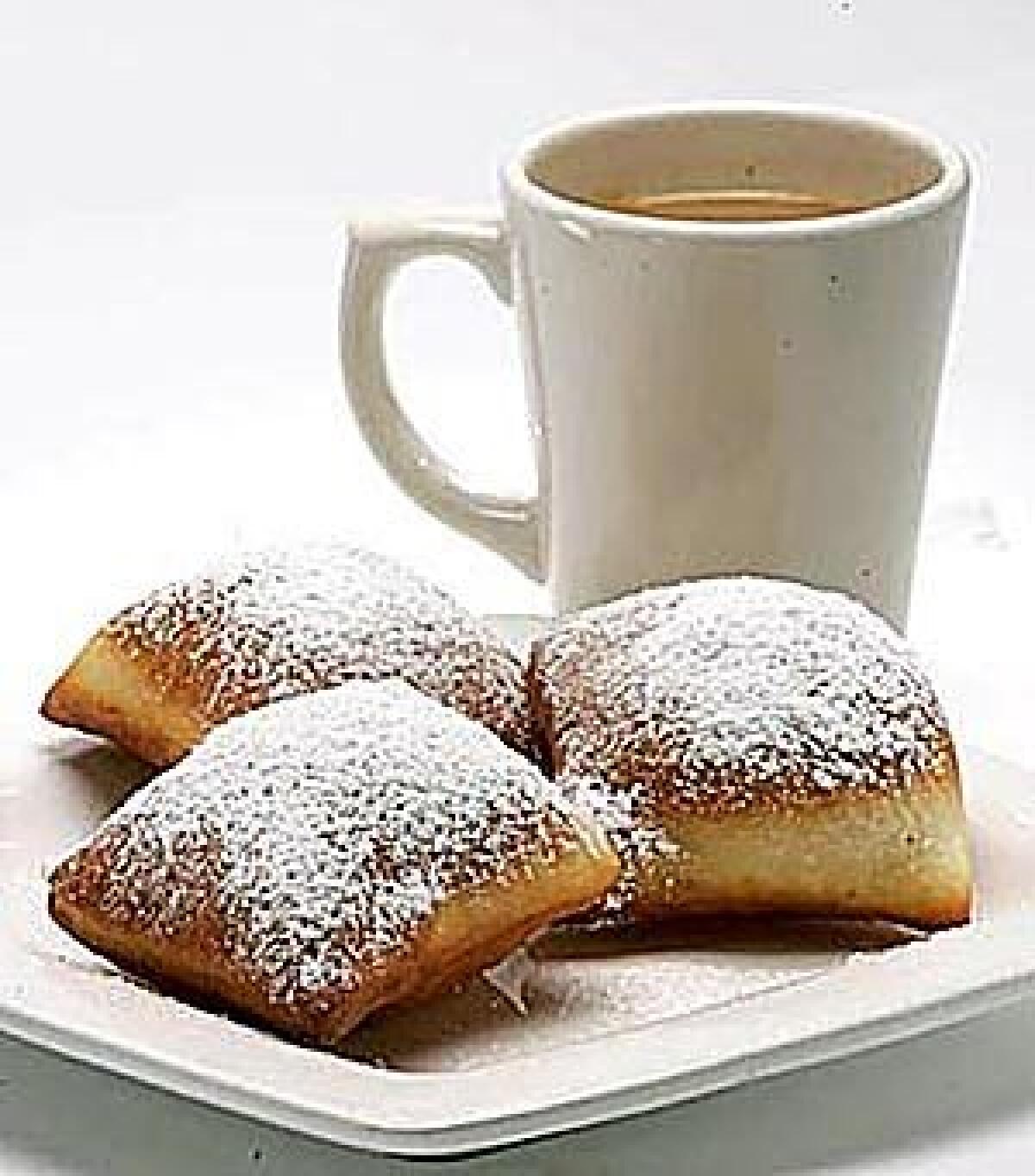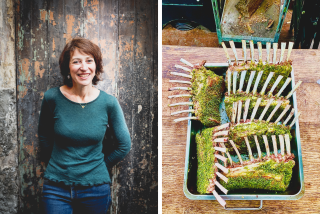It’s air time

- Share via
DEEP-frying is the bacon of cooking techniques: It makes everything taste better. Do it with beignets, though, and you get the irresistible results in a more lyrical package. The word is almost as satisfying to say as the real thing is to eat. Beignets sound so much lighter and airier than fritters, but they are no easier to pass up.
The most famous beignets in this country are a New Orleans specialty: squares of yeasty dough fried until puffy, then smothered in powdered sugar, to be eaten with the local chicory coffee. But beignets in other shapes and forms, both savory and sweet, are constantly turning up in restaurants. The word looks so seductive on a menu -- scallops and cauliflower sound nice enough together, but beignets make them impossible not to order.
Beignets could be considered “freedom fritters.” Not only is the name (pronounced bayn-YAY) French, but beignets also can start with any number of doughs or batters, be left plain or filled with anything from anchovies to zucchini and be served as hors d’oeuvres, side dish, garnish or dessert. Learning to make them is also liberating -- something as simple as apples can be transformed with a dunk in a frothy batter and a dip in bubbling oil, and the method works with nearly any ingredient.
A rich history
YOU won’t find beignets in Julia Child’s masterwork, but they are a staple of French cuisine. Just to give a sense of how versatile they are, consider the number of entries in Larousse Gastronomique (which, oddly enough, uses the English translation as the heading for the whole section). The straightforward recipes include sweet versions such as apricot, banana, rice and fig, and savory variations with cheese, eggplant, artichokes, chicken liver, shrimp, salsify, mushrooms, even fish roe, lamb’s brain and calf’s tongue. Then there are Viennese beignets (brioche-like, with jam), Nanette beignets (brioche sandwiched with custard and candied fruit), Hungarian beignets (with onion and paprika) and Bernese beignets (like deep-fried mini croques monsieur). The “see also” beignets include local versions from Lyon, Montpellier, Strasbourg and Nantes, among other cities. And 17 other recipes are scattered throughout Larousse for beignets by other names, such as acra (made in the Caribbean with salt cod) and fritto misto.
Beignets go back centuries in France, but they are still evolving there and here. Epicurious.com has recipes for them made with okra or with apple cider, not to mention with very American peanut butter. Starchefs.com references versions made with edible flowers, zucchini blossoms, chocolate, frogs’ legs, Dungeness crab and kumquats. In Britain you could probably find them made with Mars Bars.
The simplest beignet is that most famous one from New Orleans, which is like a flat doughnut without a hole. The yeast dough is a speedy production, with no rising or real kneading needed; then you just have to roll it out very thin and cut it into squares to drop into hot oil and fry fast. The classic recipe uses very little sugar and no spice, but a little ground cardamom, cinnamon, nutmeg or ginger will add a jazzy undertone. If you aren’t daunted by deep frying in the morning, they can be a great start to a Saturday or Sunday.
Beignets made with a fritter batter are much more common. It can be as simple as a cup of flour beaten with three-quarters of a cup of milk, an egg, half a teaspoon of salt and a tablespoon of butter; this works for coating sliced vegetables such as onions or zucchini or for oysters or shrimp. Add a quarter of a cup of sugar, a teaspoon of baking powder and cinnamon to taste and you get a puffier batter for sliced fruit.
An even airier beignet batter can be made with club soda or beer as leavening, with no eggs or milk needed. It can make even a sturdy vegetable like cauliflower seem light, as chef de cuisine Josh Emett does at Gordon Ramsay’s Maze in New York City.
The pastry variations
Achoux paste -- melted butter and milk mixed with flour and lightened with beaten eggs, the usual dough for gougères or cream puffs -- can also be the basis of a sensational beignet, especially with grated Gruyère blended in. In France those are considered soufflé beignets because the dough expands so much in the hot oil; they can be filled with cheese or with jam before frying. In Spain they are called buñuelos (literally, puffs).
The late chef and cookbook author Leslie Revsin made her name in New York City in the early 1980s with Roquefort beignets, a whole different production. The pungent cheese is encased in crepes, like blintzes, that are dipped in fritter batter and deep-fried so that the Roquefort oozes. They take a little more work than the usual but are richly rewarding as the first course for a dinner party. Unlike most beignets, they need a knife and fork.
If there is a trick to beignets, it is only in the cooking. The oil should be at 375 degrees, so a candy thermometer is essential if you do not have an electric deep-fryer. The beignets will sink to the bottom, then pop right up as they lighten and cook to golden brown. If the oil is too hot they burn before cooking through; too cold and they turn to grease sponges.
Beignets should be fried a few at a time, without crowding the pan. Otherwise they clump together and bring down the temperature of the oil too fast.
You can hold beignets briefly in a warm oven, but they really should be eaten as soon as they have drained on paper towels. Luckily, resistance is futile.
More to Read
Sign up for The Wild
We’ll help you find the best places to hike, bike and run, as well as the perfect silent spots for meditation and yoga.
You may occasionally receive promotional content from the Los Angeles Times.










